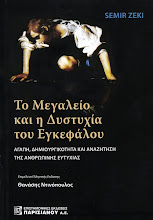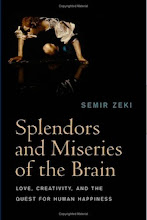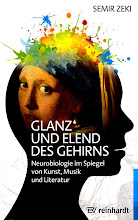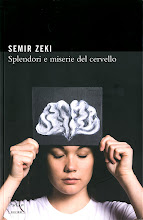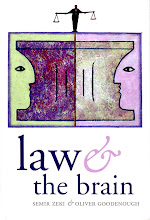It was only over 70 years later that Verrey’s evidence re-surfaced when it was found that there is indeed a part of the visual brain, located in the area that Verrey had indicated, damage to which leads to cerebral achromatopsia.
Verrey’s single case study is rather less well know today than the single, and very brief, case study of Pierre Paul Broca. Broca’s single case study revolved around a patient called Tan, who had lost the ability to speak and had been admitted to hospital 10 years before Broca examined him. Tan was only able to utter a single word, Tan; hence the name given to him. Broca started studying him on 12 April 1861, four days before Tan died. At autopsy, the causative lesion was shown to be in the left frontal lobe. Broca did not waste time; he delivered his results and his conclusion to the Société d’Anthroplogie in Paris on the afternoon of the autopsy; he postulated that the third convolution of the left frontal lobe is critical for the production of articulate language and the area is now commonly referred to as Broca’s area. It constitutes a foundational landmark in the study of brain activity as it relates to language and has been described as one that “revolutionized psychiatry” (Scientific American, 2013). But, of course, Broca was fiercely attacked for his single case study, the significance of which became evident much later, retrospectively.
Not much later, in 1889 Hughlings Jackson published a single case study in Brain (of which he was one of the founders). He wrote of a Dr Z who suffered from an unusual type of epilepsy which had, as a consequence, a bewildering amnesia; Z retained consciousness during his seizures and could even examine patients and prescribe the correct medication but had no recollection of having done so later. CR Butler (2006) wrote in Practical Neurology that similar cases have appeared sporadically since the description of Hughlings Jackson but that they often go unrecognized – a situation which refusal to publish single cases presumably promotes or at least does not help.
Among the more recent, and more extensively studied, single cases, is patient HM, whose memory system was charted extensively by Brenda Milner and her colleagues; HM developed severe memory problems after surgery for epilepsy, which included resection of the hippocampus and adjacent structures. The initial studies on HM were published by Milner and Scoville (1957) and, according to Larry Squires (2009), met with resistance “especially because of the difficulty for many years of demonstrating anything resembling his impairment in the experimental animal”. As with Broca’s study, the importance of this single case became apparent only later, i.e. retrospectively, and it is now generally agreed that this single case revolutionized our knowledge of human memory mechanisms. Larry Squire has described patient HM “as probably the best known single patient in the history of neuroscience…Work with him established fundamental principles about how memory functions are organised in the human brain.”
It would be hard to find an equivalent description of work based on a study of scores of patients, with detailed statistical tables, rather than a single one. And in view of Larry Squire’s view of why Milner and Scoville evidence met with resistance, it is interesting to note here that there is another single case study published (yes, you guessed correctly again) in Brain (1983 and 1991). This is of patient LM who became akinetopsic (lost the ability to perceive objects when in motion) after bilateral cortical lesions affecting the territory of V5, the brain area critical for the perception of visual motion. Even though the physiology of V5 had been charted extensively in the monkey by then (V5 is perhaps one of the most extensively studied cortical areas), nothing of the same severity and longevity has been described in experimental animals.
In fact the exclusion of single cases, or their absorption into a study of the many because their authors could not bring themselves to believe in the results obtained from outlier, single cases can, and has, seriously compromised results reached from study of groups of patients. A good example is that of the much-revered study by Sir Gordon Holmes, of the effects of lesions in the primary visual cortex (area V1) in humans (Holmes 1918). Among Holmes’ patients was one – a single case – whose condition did not conform to that of the group. This one patient, though also blinded by a lesion in his V1, was nevertheless able to experience visual motion consciously when a moving stimulus was presented to his blind field. Holmes grappled with this one patient – especially in light of a similar discovery (but derived from 5 patients) described a year earlier by George Riddoch (1917) – but Holmes evidently decided against publishing it as a single case; instead, he absorbed this single case into his other cases and lost a great opportunity. His reluctance to isolate this single case was doctrinaire; Holmes cared nothing for any study that showed residual and specialized visual capacities after lesions in V1. In spite of the single case in his own study, Holmes dismissed the findings of Riddoch (and with it his own single case); Riddoch’s study had similarly shown that conscious experience of visual motion in patients otherwise blinded by lesions in V1 is possible. Holmes wrote that Riddoch was “certainly incorrect” because “…in all my cases the blindness was total” (my emphasis). Had there been a journal in those days that encouraged the publication of single case studies or at least accepted them if only for review, Holmes might have been encouraged to consider his single case more seriously and describe it separately. At any rate, his much revered 1918 paper has, in my view, suffered a serious intellectual setback resulting from not describing a single case that did not conform to the results obtained from examining many cases.
In fact, a study published in Brain in 1993, based on (you guessed it again) a single case showed that Riddoch was right and that patients blinded by lesions in V1 can perceive motion selectively and consciously, thus questioning a doctrine that supposed that such patients, when they see at all, can only “see” unconsciously (the so-called syndrome of blindsight).
It is now well attested that George Riddoch was right and the phenomenon has indeed been deservedly named after him.
Note in passing that this single case study of 1993 was published in Brain when its editor was the neurologist Ian MacDonald. Brain currently has the much-misguided policy of strongly discouraging single case studies (see below).
There is, in brief, a price to be paid for ignoring single cases and a good deal to be said for taking them into account, if only to review them seriously, as with any other scientific study. I have given only a few examples above, but there are many more that can be given.
Imagine therefore my surprise when I received on Monday 27 November 2023 a letter from the Editor of Brain Communications in response to a paper that my colleagues and I had submitted to that journal on Friday 24 November 2023. The paper described the results obtained from examining an unusual single patient who had what seemed to us very interesting visual disturbances. The nature of these disturbances and their scientific validity is not at issue here. What is interesting is that the paper was returned after spending a weekend on the editor’s desk, with the following comments:
“After careful consideration [during the weekend of Friday November 24 ending on Monday November 27], I regret to inform you that…we do not typically consider case studies as it is difficult to draw robust conclusions about the neurobiology of disease or about the wider implications of the work for other people” (my emphasis), a statement that is evidently based on scientific ideology and policy rather than on the science itself since it is hard to believe that the paper was carefully considered in any other sense than that it was a single case study that did not fit with the journal’s rigid policy. As for not drawing robust conclusions from single case studies, please read above again.
The policy behind such a statement has scientific mediocrity writ large all over it – it does both neurobiology and its practitioners a serious dis-service; it is based on a crass ideology and policy that discourages any neurologist who may come across a patient with an interesting syndrome to pursue their studies, knowing full well that there are out there journals with a pretence to eminence who follow the identical crass policy, with acceptance of articles dictated not by scientific interest but by scientific diktat regarding what scientific papers can and cannot be reviewed, let alone published. It would be totally useless to counter such diktats by saying that a scientific study is either good or not good – good science often does not proceed by following rules established by editors.
Another example is provided by a sister journal to Brain Communications, the journal Brain itself (of which, incidentally, Sir Gordon Holmes was editor between 1922 and 1927). The current, and equally idiotic, policy of this venerable journal, established in the 19th century and in which many landmark papers in neurology have been published, is as follows: “…single case studies are not considered. More detailed studies of single cases may - in rare instances - be considered as a Report…only when they resolve definitively an important problem in the field or when the data lead to a significant conceptual advance. Studies of single cases that can be readily performed on groups of patients will not be considered.”
What an extraordinarily unscientific statement: since when has any scientific study resolved definitively an important problem? And the whole point of single case studies is that they cannot readily be performed on groups because naturally occurring lesions in the brain are never perfectly localised to one and the same place. And as to the data leading to a significant conceptual advance, surely that can only be judged retrospectively, after a single case study has been published, as indeed has been the case with the single case studies of Verrey, Broca, Hughlings Jackson and Milner & Scoville – among others.
But there is of course always the argument based on statistics, generally a good fall back position in attacking single case studies. I will not go into that here because it has been compellingly argued against in a recent study by Nickels et al. in an article entitled Single case studies are a powerful tool for developing, testing and extending theories, published in 2022 in Nature Reviews Psychology. I doubt that it will influence editors who will not consider single case studies although it should because journals have a responsibility to serve their subjects well.
There are of course many merits to studies that involve scores of patients, and which are acceptable to these editors, in principle. I will not details these merits here but leave it to those journals that proscribe single case studies to do so.
Semir Zeki

